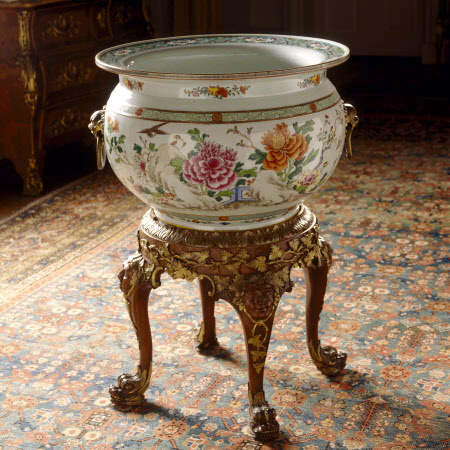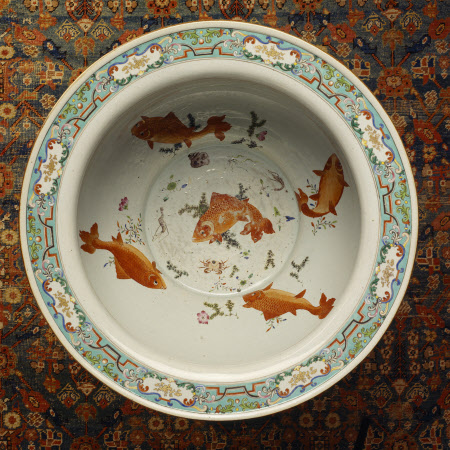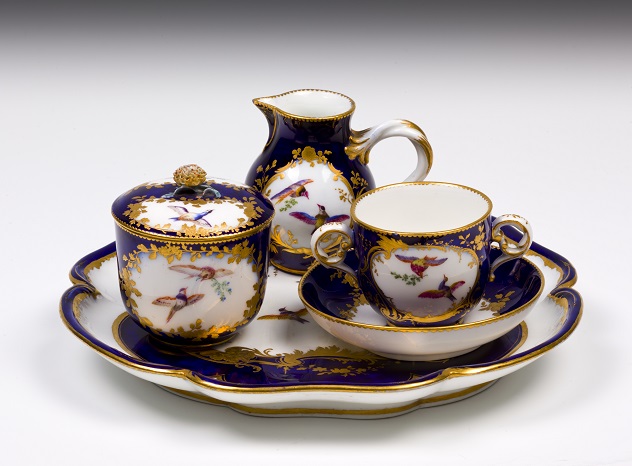Fish bowl
Category
Ceramics
Date
1735 - 1740
Materials
porcelain, polychrome enamels (‘fencai’), gold, gilded metal
Measurements
428 mm (Height); 598 mm (Diameter)
Place of origin
Jiangxi
Order this imageCollection
Wallington, Northumberland
NT 581662
Summary
A Jingdezhen porcelain fish bowl, Jiangxi province, painted in 'fencai' enamels, possibly in Guangzhou (Canton), Guangdong province, China, C.1735–40. With lion’s head masks of Buddhistic origin made of unglazed porcelain, dressed in brown slip and gilt to resemble bronze. They are fitted with gilt-metal drop-ring handles for ease of transport. The decoration in ‘fencai’, or ‘famille rose’, enamels, possibly executed at workshops in Guangdong (Canton) catering to the export trade. The exterior depicts tree peonies and rockwork. The interior is painted with colourful goldfish, crayfish, a crab and aquatic plants, revealing that it was intended as a fishbowl. On a stand, see NT 582347.
Full description
When the agriculturalist and social observer Arthur Young visited Wallington in 1769 he noted that ‘in one corner’ of the Saloon there was a ‘noble china cistern’. This large Chinese porcelain ‘cistern’ or fishbowl is still there, on a partly gilt walnut stand made in about 1750, which is carved with Bacchic masks and grape vines, mirroring the carved decoration on the Saloon’s chimneypiece. When Young visited Wallington, it was the home of the colliery and lead-mining heir Sir Walter Calverley Blackett, 2nd Baronet (1707-77). His principal house was Anderson Place, Newcastle, but in the 1730s he had transformed the former hunting lodge at Wallington into a Palladian pleasure palace, designed for entertaining and politicking, serviced by his famously well-stocked wine cellar. The ornate bowl’s shape, which first appeared in Chinese porcelain in the 1720s, closely resembled seventeenth-century archaistic censers (‘gui’). An inscription on an example dated 1734 identifies it as an incense burner. The Wallington bowl has lion’s head masks of Buddhistic origin made of unglazed porcelain, dressed in brown slip and gilt to resemble bronze. They are fitted with gilt-metal drop-ring handles for ease of transport. The decoration in ‘fencai’, or ‘famille rose’, enamels depicts tree peonies and rockwork, possibly executed at workshops in Guangdong (Canton) catering to the export trade. The interior is painted with colourful goldfish, crayfish, a crab and aquatic plants, revealing that it was intended as a fishbowl. Goldfish were first recorded in England in 1691 but were routinely imported from China as private trade only from the 1730s, perhaps influenced by descriptions of the goldfish kept as pets by Chinese courtiers. The naturalist George Edwards noted that Charles Lennox, 2nd Duke of Richmond (1701-50), of Goodwood, Sussex, had a ‘large Chinese earthen Vessel full of these Fish brought to England’ and Horace Walpole famously bred goldfish at Strawberry Hill, Twickenham, as gifts for friends. Such bowls were soon adapted as cisterns for rinsing drinking glasses or chilling wine bottles. This use was no doubt suggested by their similarity to European metalware cisterns, which also had drop ring handles. In elite English households the porcelain cisterns were usually acquired in pairs and fitted with ornamental stands, as supplied by Thomas Chippendale in the 1770s to two Yorkshire houses, Nostell Priory and Harewood. Around 182, the Trevelyans, now abstainers from alcohol, converted the Wallington cistern into a jardinière. Nineteenth-century paintings of the Saloon show it planted first with sand lilies (Veltheimia capensis) and then, in 1853, with calla lilies (Zantedeschia aethiopica). In the 1920s it was once again filled with water to ‘make the fish come alive’ and entertain the Trevelyan children. Text adapted from Patricia F. Ferguson, Ceramics: 400 Years of British Collecting in 100 Masterpieces, Philip Wilson Publishers, 2016.
Provenance
Given by the Trevelyan family in 1970 in lieu of (then) Death Duty, later called Capital Transfer Tax (1982).
Credit line
The Trevelyan Collection, Wallington, Northumberland


